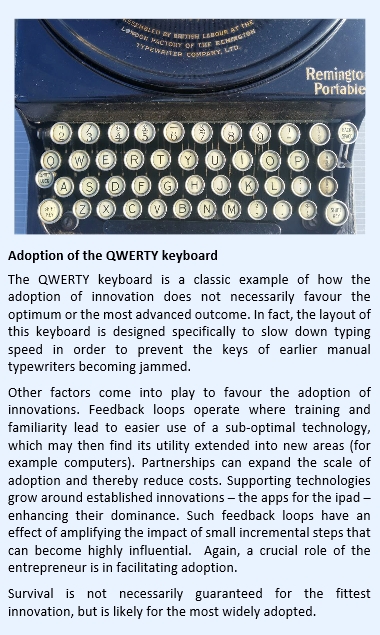Prosperity, health, longevity – all good things in principle but they come with a cost. In this major new section of Chief-Exec.com we seek to discover how society can pay the bill
Outstanding innovations over the past two centuries have built a modern society in which a long, generally healthy and reasonably prosperous life is the expectation rather than the exception.
Problems created by this progress are also becoming increasingly evident – in climate change and in the costs of care in an ageing affluent society. Innovation appears again, this time touted as the panacea.
Therefore, one might be forgiven for concluding that innovation is a good thing and generally, in the longer term, this might well be the case. Niccolò Machiavelli (pictured below) though aired his doubts in 1513 in The Prince, in which he observed that:
 … There is nothing more difficult to take in hand, more perilous to conduct, or more uncertain in its success, than to take the lead in the introduction of a new order of things. Because the innovator has for enemies all those who have done well under the old conditions and lukewarm defenders in those who may do well under the new.
… There is nothing more difficult to take in hand, more perilous to conduct, or more uncertain in its success, than to take the lead in the introduction of a new order of things. Because the innovator has for enemies all those who have done well under the old conditions and lukewarm defenders in those who may do well under the new.
Not much has changed in half a millennia. In the short-term the beneficiaries of innovation are often less numerous and with far less to lose than the comfortable stakeholders of an agreeable status-quo. Innovation can be regarded as a nuisance, rather like the Asian hornet.
In about 2004 hibernating queen hornets (Vespa velutina) awoke in Lot-et-Garonne, south-west France, far away from their Shanghai origins, having been transported in a shipment of Chinese pottery. The bees of Southern France were soon under threat from this voracious predator, which can surgically detach their head, legs and wings to feed the remaining high-protein thorax to their young. In the favourable climate of southern France, by 2010 the species had spread into 39 departments and crossed the border into Spain. Apicultures had been ravaged. A new species had entered French fauna and the distressed indigenous inhabitants have to learn to live with it.
The disruptive invasion of species into ecosystems is well known. Rodents from the ships of early explorers of the pacific islands and the rabbits of Australia are two examples. Biologists have extended the principle into the social and cultural domain. The meme has been proposed by Richard Dawkins in The Selfish Gene as the cultural equivalent of the gene, through which plays out a competition, a natural selection and replication of the most favoured ideas and dominant cultural phenomena. Large advertising budgets are committed to the transmission of high-value memes as brand names compete for their place in the psyche of a society.
Just as the biologists have ventured tentatively into the social domain, economists have travelled in the opposite direction, as the disruptive and potentially destructive effects of innovation can similarly destabilise an economic environment.
The term “creative destruction” was adopted[1] by the economist Joseph Schumpeter in his 1942 book Capitalism, Socialism and Democracy to describe this impact of innovation that “incessantly revolutionises the economic structure from within, incessantly destroying the old one, incessantly creating a new one”. While Schumpeter denounced any direct association with biology, his work became one of the foundations of an emerging discipline of evolutionary economics that seeks to deploy biological analogy in economic analysis.
Earlier, the second half of the 19th century was a time rich in the sharing of ideas and metaphors between biology and economics. Charles Darwin is said to have found inspiration in the challenging proposals of Thomas Robert Malthus on economic survival in inevitable circumstances of limited resources. The theory of the evolution of species by natural selection developed by Darwin was extended into sociology by Herbert Spencer and inspired the American economist Thorsten Veblen to consider how the preferences of individuals evolve in relation to their economic environment. Veblen went onto expound the concept of conspicuous consumption through which the wealthy choose to consume expensive goods as an overt display of their wealth, effectively being the vector for the memes that were propagating through their behaviour.
As the methods and models of conventional neoclassical economics grew in sophistication and widespread adoption through the first half of the 20th century, the alternative interpretation of evolutionary economics fell into disrepute. The discipline had become tainted by association with the atrocities of eugenics. Its rehabilitation and re-emergence followed Schumpeter’s publications in which innovation was cited as a source of variation upon which act the forces of natural selection to determine which products, companies and entrepreneurs survive and thrive in an ever-evolving marketplace.
The assumptions of evolutionary economics are quite different from the neoclassical theories of marginal supply and demand. Innovations are continually disturbing the economic equilibrium on which the latter are based. The adventurous, risk-taking entrepreneur is at odds with the neoclassical rational economic agent. It is not surprising, therefore, that there is no great consensus both within evolutionary economics itself – after all it is a relatively new field of enquiry – and between evolutionary economics and the more established and conventional economic analyses.
Along with Schumpeter, the Austrian-British economist and philosopher Friedrich von Hayek considered how the abstract rules, organisational routines, practices and know-how of companies and societies can represent their intellectual and cultural DNA, which has evolved to become increasingly effective in facing up to new challenges, mainly through trial and error and in a direct analogy to Darwin’s principle of natural selection. Apprenticeships and training then become vital for passing on this key economic survival information to future generations.
 The entrepreneur is the agent that introduces variation and disrupts an economic equilibrium. Selection also operates at this level, favouring those entrepreneurs with the capability of overcoming the hostility and inertia identified by Machiavelli in “the incredulity of men, who do not readily believe in new things until they have had a long experience of them”.
The entrepreneur is the agent that introduces variation and disrupts an economic equilibrium. Selection also operates at this level, favouring those entrepreneurs with the capability of overcoming the hostility and inertia identified by Machiavelli in “the incredulity of men, who do not readily believe in new things until they have had a long experience of them”.
Individual, social and political factors combine in the evolutionary selection process. It is often new technology that embeds current savoir faire in a disruptive innovation and then the intervention of the entrepreneur instigates a continuous evolution of know-how as a dynamic process of technological and social change. Successful practices will reproduce and become the automatic routines of companies and individuals, until the next innovation shockwave disrupts the evolved status quo. This, according to Schumpeter, is the essential dynamic of the capitalist system.
Since the 1980s, following the publication by Nelson and Winter of their opus An Evolutionary Theory of Economic Change, the discipline of evolutionary economics with a specific focus on innovation and its role in development has taken off with a large and creative array of tools and analyses.
The perspective of a continuously evolving marketplace, where uncertainties prevail and reliable information is, at best limited, does reflect reality. The economic rationale of organisations must then be imperfect but improvable. Survival depends on the response of organisational routines and know-how that lead to the decisions that maintain sustainability and profitability.
This dynamic differs from the classical view of companies acting to maximise their profits on the basis of fully informed rational decisions. The essential routines form the acquired memory of each organisation, existing in the competences of its individuals and the collective knowledge embedded in its products and systems of production and commerce, both of which must evolve to maintain a sustainable operation. The diffusion of best practice will propagate successful routines, which must mutate to integrate in different organisations and environments.
Innovation is therefore both internal to the company in a continual modification (mutation) of its constituent routines as well as in the external drive to innovate to survive as described by Schumpeter.
Notes
[1] The term was apparently first used by Karl Marx for a different mechanism of capitalist economic development.
Follow on twitter: @johnmegan




